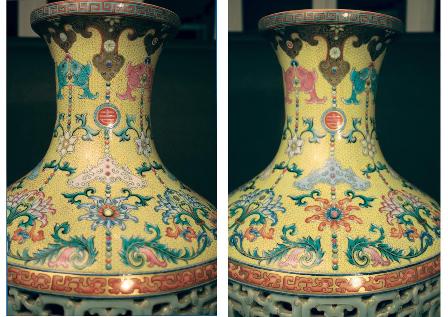| Chinese vase sale |

|

|

|
| Features | ||||||||||||||||||||||||||||||||||||||||||||||||||||||||||||||||||||||||
| Sunday, 21 November 2010 | ||||||||||||||||||||||||||||||||||||||||||||||||||||||||||||||||||||||||
|
A MULTI-BILLIONAIRE Chinese industrialist has paid an incredible £53,000,000 at a London auction for a Qianlong Dynasty vase, just 16 inches tall.
The industrialist, who has giant projects in Beijing, Shanghai and other big cities, sent his representative to bid a world-record price for a Chinese artefact.
Young, long-haired and wearing jeans, the successful bidder was given a front-row seat on a gilded couch before the auction started.
There were seven serious bidders, all of them Chinese, for the elaborately-decorated vase, with its iconic ovoid body covered by porcelain lattice work half-hiding a smaller intricate urn.
The vase was owned by Qianlong, the fourth emperor of the Qing Dynasty and dates back to at least the 1740s. It was illegally smuggled out of China at the end of the Second Opium War in 1860, probably by a British Army officer, when Imperial palaces in Beijing were ransacked and looted.
Nobody knows how the vase ended up in a modest bungalow in suburban Pinner, north-west London in the 1930s. For decades, it was used as a book end and left to gather dust on the top shelf of a wooden bookcase, after a well-known television antiques expert said it was a clever fake.
The owner of the vase died several years ago and his widow passed away shortly after. It was only when their son and daughter were clearing out the house that the vase was taken to their local auctioneers, Bainbridges, of Ruislip.
As experts studied the item, it became clear that here was a genuine Chinese antiquity, a real treasure. An initial value of £1,000,000 was placed on the elaborately-decorated relic.
But as more cultural heritage historians and academics examined the artefact, valuations increased dramatically.
A Bainbridges official wrote on his small company’s website: “I can’t easily explain the excitement that is building up here in Ruislip” – a statement which may never be repeated in this sleepy, working-class town which boasts that it’s the home to Eastcote Hockey Club and which has High Street buildings yawningly called The Swan and The Duck House.
At the auction, there was frenzy and mounting excitement as bids crackled skywards, at the astonishing rate of £1,000,000 a time. Somebody offered to pay £5,000,000 – but then the real, determined bidders stepped in and the price shot up to 10, 20, 30, 35 and way past £40,000,000.
After 30 minutes of one of the most astonishing auctioneering sessions ever seen, the hammer came down – and with commission and Value Added Tax, the small case cost the buyer a mind-bogling £53,000,000.
Some big newspapers said the buyer was the Chinese Government. But I find this suggestion absurd – I do not believe the staid, old-guard directors of the State Cultural Relics Bureau on Beijing would ever despatch a young, long-haired man wearing jeans to London to spend 560,835,000 Renminbi of the Government’s money. And a Government representative would not agree to sit in the limelight in the front of the auction house, with cameras peering at him.
I fancy the bidder was the son of an industrialist who failed to buy another Qianlong Dynasty vase which was sold at auction in Hong Kong earlier this year for a mere £20,000,000. Dad’s instruction to his son was probably: “Don’t come back from London without THIS vase – pay as much as you need.” So, the vase may now be sitting in the billionaire’s dining room, an interesting conversation piece when wealthy friends come over for a meal.
The identities of the lucky brother and sister who sold the relic are also being secret, but they are probably currently on holidays in the Caribbean sun and buying lottery tickets with lots of 8s.
Few people know this, but the British Museum has scores of relics, looted from palaces, Government buildings, mansions, museums, tombs and monasteries, hidden away in their secret vaults. The artefacts were smuggled out of China by British explorers, adventurers, treasure hunters and Army officers and soldiers.
The British Museum told me that their Chinese art works include Buddhist scrolls, paintings, documents and books from the Dunhuang Caves. Some of the items were simply stolen, others were handed over by monks for gifts of food, Western trinkets and small amounts of money.
The museum refuses to hand back a single item to China – just as it refuses to return the Elgin Marbles to Greece, or the hieroglyphic-busting Rosetta Stone back to Egypt.
Museum officials say its China Gallery is not large enough to exhibit all their Chinese masterpieces. The artefacts in vaults are not easily-accessed by the public, but can be studied by historians, academics and scholars.
China last year set up a Chinese Cultural Relics Recovery Programme to boomerang heritage treasures back to China and its people. The United Nations estimates that there are 167,000,000 historic national relics in 200 museums in 43 different countries – and most have been stolen and illegally smuggled out of their countries of origin.
In the meantime, souvenir collectors all over Britain are examining their oriental urns and vases – but whether they find another valuable ancient Chinese container is a matter of pot luck.
ALFRED LEE
This email address is being protected from spam bots, you need Javascript enabled to view it
Only registered users can write comments! |
||||||||||||||||||||||||||||||||||||||||||||||||||||||||||||||||||||||||








